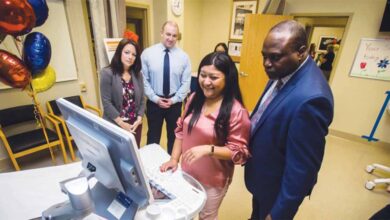How to prepare for ACOs’ mandatory shift to eCQM reporting


Carol Ann Hudson is assistant vice president, quality and clinical operations, population health, at Lifepoint Health, a national health system and accountable care organization based in Brentwood, Tennessee.
Hudson’s career began as a programmer writing code to build hard drives for Digital Equipment Corporation. The hard drives were used in test rockets for DEC’s space program. The goal was to continually design smaller and smaller hard drives to save space and weight. She was one of the earliest women in IT at that organization, and that space program experience continues to serve her today.
We interviewed Hudson to gain insights from her experience as a woman executive in health IT, and to talk about the impending new Electronic Clinical Quality Measures reporting requirements for ACOs, among other topics.
Q. Please provide an overview of your experience in health IT, including as a woman in ACOs and population health.
A. A few years after Digital Equipment Corporation, I was offered the opportunity to implement an electronic practice management system and EHR for a local, multi-location medical group. This is when my healthcare career began. My physician mentor encouraged me to attend nursing school, which I completed in 1993, and I’ve obtained several nursing and IT certifications since then.
After working for several years as an RN in the emergency department, trauma and intensive care unit, I moved into nursing administration and nursing informatics. I led several Meditech and MedHost implementations and then served in a variety of IT leadership positions.
Eventually, I was assigned to co-lead the meaningful use program for Health Management Associates, where our team obtained Office of the National Coordinator (ONC) certification of our internally developed electronic health record and then successfully met meaningful use objectives across 65 hospitals nationwide.
Once HMA was acquired by Community Health Systems, my focus shifted to clinical informatics with responsibility to ensure physician adoption of eprescribing, provider and nursing adoption of computerized provider order entry, and overall compliance with all meaningful use criteria.
Expanding on my meaningful use experience, in 2016, I joined Lifepoint Health, a diversified healthcare delivery network comprised of more than 62 community hospital campuses, more than 60 rehabilitation and behavioral health hospitals, and 250 additional sites of care, including managed acute rehabilitation units, outpatient centers and post-acute care facilities.
The company also has eight clinically integrated networks that participate in the Medicare Shared Savings program. Upon joining Lifepoint, I led the organization’s meaningful use program for both hospital and ambulatory service lines.
As population health evolved in 2018, my team moved from IT to focus on the Medicare Shared Savings program and help expand our AdvantagePoint Health Alliance networks. I currently serve as assistant vice president for quality and clinical operations in population health for the organization.
Progression into informatics was a natural transition for me based on my early computer experience at DEC. Unlike other nurses who had difficulty transitioning from paper to electronic documentation and EHRs, I found the shift easy and comfortable.
Q. What are the upcoming changes in quality reporting for ACOs, particularly the shift from Web Interface to eCQM reporting, by 2025?
A. Quality reporting for ACOs historically has been done via CMS’ Web Interface. CMS annually sends a random list of Medicare patients to each ACO and asks them to submit quality measure outcomes via this interface. ACOs would comb through the EHRs of participating practices, find the necessary data and perform the reporting.
The new eCQM reporting protocol changes the reporting process for ACOs and seeks to better align ACO quality reporting with the Merit-based Incentive Payment System (MIPS). Here are specific changes:
-
No longer just Medicare patients. Quality reporting now includes all payer types.
-
Denominator is now all patients who meet the criteria for each quality measure.
-
The number of measures is reduced to three mandatory clinical quality measures and three additional measures.
-
These include screening for depression and follow-up, hemoglobin A1C: poor control, and controlling high blood pressure. The additional measures cover CAHPS surveys, readmissions and unplanned admissions.
CMS’ plan to move to eCQM was released in 2020. But in response to industry pushback, CMS made eCQM reporting optional for 2021-2024. It is now mandatory for 2025.
Here at Lifepoint Health, we decided to make the transition to eCQM reporting earlier versus later. Our decision has paid off in numerous ways with two of our networks in the first eight early adopters group, and we were the only ACO reporting quality measures from multiple EHR systems.
Q. What is the implication of this reporting change and expansion for ACOs’ IT teams and quality departments – moving from a selection of measures to mandatory reporting on all patients. Can you elaborate on the implications of this change and the challenges ACOs may encounter?
A. Lifepoint Health adopted eCQM very early in the process. Other ACOs are just now catching up. Early adopters were given concessions by CMS to test the system, making it easier to reach quality benchmarks. These concessions have been financially beneficial for Lifepoint while also giving us time to expand reporting to all patients and continually improve our quality results.
From a technology perspective, the change dramatically increases the amount of data required to be gathered from participating providers. ACOs with a single EHR across all participating providers shouldn’t have a tremendous challenge here.
But a single EHR is the exception rather than the norm. For example, Lifepoint Health now pulls data from 11 EHRs across all our participating providers. This remains a challenge for most ACOs.
Q. Where is Lifepoint in the process?
A. In order to meet the quality reporting requirements of MIPS and our ACOs, Lifepoint Health engaged with FigMD, now MRO Corp., in 2019 to continually pull data from all of our participating EHRs. By pulling all data from the very start, we were prepared to meet eCQM requirements early but also consistently measure practice performance for each quality measure across all patients.
Now our efforts are focused on fine-tuning documentation for each measure, streamlining the reporting process and continually improving care quality.
We also have much greater transparency into our quality performance at any time and avoid fire drills when payers provide gap lists for review. Since all data is pulled across practices, we only need to work by exception for any missing measures data.
For example, mammogram results may be faxed from a participating physician office versus entered as discrete data into the EHR. We can easily identify the gap, find the missing information, and enter it quickly into the EHR for quality reporting and other purposes.
Q. From a workflow perspective, how do you see this transition impacting Lifepoint’s day-to-day operations? Are there specific workflow nuances you’re preparing for? Or that other ACOs should start addressing?
A. Since we have been pulling all data across our providers and EHRs since 2019, there won’t be major workflow changes for Lifepoint Health on the IT and reporting side. All eight of our networks are already reporting via eCQM. However, for ACOs that haven’t started the process yet and have multiple EHRs, there will be significant workflow changes ahead.
One area we are watching is a slow return of higher benchmarks to receive shared savings incentives. Our networks are currently performing well above the 10th and 30th percentile levels, but we anticipate that CMS will raise the bar again over time. We’ll keep an eye open for new rules to be released by CMS in 2024 related to percentile benchmarks.
Q. As ACOs navigate the complexities of eCQM reporting, what strategies can they employ to ensure proper data collection from affiliated physician groups? What data feeds need to be updated and how will this be accomplished?
A. Beyond data aggregation, the shift to eCQM is about education. ACOs should work to ensure each practice is aware of the measures and how they will be held accountable. Each EHR is required to have a distinct way to capture measure data within the system and must be certified for the functionality.
Practices should be thoroughly trained on each step to document all components of the measure (for example, screening for depression) and also document follow-up for that measure if warranted (for example, treatment for depression for positive screens).
Whether it is the depression screening measure, the hemoglobin A1C: poor control measure, or controlling blood pressure, providers and their teams must know how to document within their EHRs.
The change to eCQM is about properly documenting the quality care providers already deliver. None of the actual care is outside of best practice medicine.
Q. Can you shed some light on the importance of education and training for providers and staff as ACOs prepare for eCQM reporting? What are some best practices?
A. One best practice is to focus on primary care providers for most of the training. For example, we don’t ask specialists to document depression screening, as this is best done at the PCP level and can be pulled from the PCP’s EHR.
PCPs and specialists often work together with the same patient, but the patient is only captured once per ACO in a reporting year. So we focus on eliminating any redundancy in provider requirements and de-duplicating patients to ensure they are only reported one time to CMS.
We’ve also created education sheets with best practices, tips and tricks for each EHR’s quality documentation. And we emphasize to physicians that meeting quality measures is providing evidence-based quality care for their patients. We are simply verifying that each provider documents the high-quality care he or she already provides.
Follow Bill’s HIT coverage on LinkedIn: Bill Siwicki
Email him: [email protected]
Healthcare IT News is a HIMSS Media publication.




